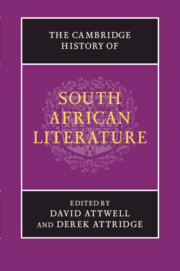Book contents
- Frontmatter
- Introduction
- PART I ORATURES, ORAL HISTORIES, ORIGINS
- PART II EXPLORATION, EARLY MODERNITY AND ENLIGHTENMENT AT THE CAPE, 1488–1820
- PART III EMPIRE, RESISTANCE AND NATIONAL BEGINNINGS, 1820–1910
- PART IV MODERNISM AND TRANSNATIONAL CULTURE, 1910–1948
- PART V APARTHEID AND ITS AFTERMATH, 1948 TO THE PRESENT
- 19 The fabulous fifties: short fiction in English
- 20 Writing in exile
- 21 Afrikaans literature, 1948–1976
- 22 Afrikaans literature after 1976: resistances and repositionings
- 23 The liberal tradition in fiction
- 24 Black Consciousness poetry: writing against apartheid
- 25 Popular forms and the United Democratic Front
- 26 Writing the prison
- 27 Theatre: regulation, resistance and recovery
- 28 The lyric poem during and after apartheid
- 29 Writing and publishing in African languages since 1948
- 30 Writing the interregnum: literature and the demise of apartheid
- 31 Rewriting the nation
- 32 Writing the city after apartheid
- PART VI SOUTH AFRICAN LITERATURE: CONTINUITIES AND CONTRASTS
- Index
- References
19 - The fabulous fifties: short fiction in English
from PART V - APARTHEID AND ITS AFTERMATH, 1948 TO THE PRESENT
Published online by Cambridge University Press: 28 January 2012
- Frontmatter
- Introduction
- PART I ORATURES, ORAL HISTORIES, ORIGINS
- PART II EXPLORATION, EARLY MODERNITY AND ENLIGHTENMENT AT THE CAPE, 1488–1820
- PART III EMPIRE, RESISTANCE AND NATIONAL BEGINNINGS, 1820–1910
- PART IV MODERNISM AND TRANSNATIONAL CULTURE, 1910–1948
- PART V APARTHEID AND ITS AFTERMATH, 1948 TO THE PRESENT
- 19 The fabulous fifties: short fiction in English
- 20 Writing in exile
- 21 Afrikaans literature, 1948–1976
- 22 Afrikaans literature after 1976: resistances and repositionings
- 23 The liberal tradition in fiction
- 24 Black Consciousness poetry: writing against apartheid
- 25 Popular forms and the United Democratic Front
- 26 Writing the prison
- 27 Theatre: regulation, resistance and recovery
- 28 The lyric poem during and after apartheid
- 29 Writing and publishing in African languages since 1948
- 30 Writing the interregnum: literature and the demise of apartheid
- 31 Rewriting the nation
- 32 Writing the city after apartheid
- PART VI SOUTH AFRICAN LITERATURE: CONTINUITIES AND CONTRASTS
- Index
- References
Summary
In the 1950s the most popular literary form for publication was the short story: stories were not only the staple of magazines, which themselves formed a staple of entertainment before the advent of television, but were also frequently gathered into anthologies, often for schools. Black writers' attraction to the form has usually been explained by its hospitality to those who lacked the domestic space, privacy and leisure time, and perhaps the literary confidence, too, required for novels, but crucial, also, in the 1950s was the publishing opportunity provided by Drum magazine, which has given to this period the name the ‘Drum decade’. However, Lewis Nkosi's term ‘fabulous’ in his essay ‘The Fabulous Decade’ encapsulates the period's extraordinary atmosphere of romantic self-construction. Young black intellectuals, writing in English, were entering a modernity that seemed, still, theirs for the taking, and a small white avant-garde (mostly English-speaking but also including young Afrikaners) were eager to associate with them or to affiliate through writing, as if their combined presence could reverse – like a fable – the effects of apartheid.
Underpinned as it was by a liberal humanist ethos, the predominant mode of the English-language culture of the 1950s was literary realism of the kind that valorised witness and protest: art was subjugated to life. (The term ‘realism’ includes Georg Lukács's critical or bourgeois realism, naturalism, social realism and other variants.)
- Type
- Chapter
- Information
- The Cambridge History of South African Literature , pp. 381 - 409Publisher: Cambridge University PressPrint publication year: 2012
References
- 7
- Cited by

